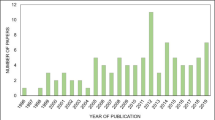Abstract
Eelgrass is the most widespread plant in temperate coastal waters. It is regarded as a useful indicator of water quality because water clarity regulates its extension towards deeper waters, i.e. the depth limit. This study analyses the use of eelgrass depth limits as a bioindicator under the Water Framework Directive (WFD). The WFD demands that ecological status is classified by relating the actual level of bioindicators to a so-called ‘reference level’, reflecting a situation of limited anthropogenic influence. The directive further demands that reference levels are defined for ‘water body types’ with similar hydromorphological characteristics, and that the classification thereby becomes ‘type-specific’.
A large historic data set on depth limits of eelgrass around 1900 was used to characterise reference levels, and a large data set from the Danish National Monitoring and Assessment Programme to characterise actual depth limits. Data represented a wide range of Danish coastal water bodies that were grouped into 10 water body types based on differences in salinity and water depth.
The analyses clearly illustrate that the definition of ecological status classes markedly influence the assessment of ecological status according to the WFD. Moreover, the study demonstrates that the use of type-specific classification implies a risk of misinterpreting ecological status. Classification problems were pronounced in spite of a unique data material on reference conditions, and the problems are likely to be even greater in cases where reference conditions are less well defined. A more robust classification was obtained by using reference levels for individual sites in a site-specific classification.
In conclusion, when classifying water quality on the basis of eelgrass depth limits, site-specific reference levels are recommended if such data are available. If more general information on reference levels is used, local conditions known to affect depth limits must be taken into account.
Similar content being viewed by others
References
Ærtebjerg, G., Andersen, J. and Hansen, O. S., 2003, Nutrients and Eutrophication in Danish Marine Waters—A Challenge for science and Management, Ministry of the Environment, Copenhagen, pp. 68–75.
Boström, C. and Bonsdorff, E., 2000, ‘Zoobenthic community establishment and habitat complexity—the importance of seagrass shoot density, morphology and physical disturbance for faunal recruitment’, Mar. Ecol. Prog. Ser. 205, 123–138.
Boström, C., Baden, S. P. and Krause-Jensen, D., 2003, ‘The seagrasses of Scandinavia and the Baltic Sea’, in E. P. Green and F. T. Short (eds), World Atlas of Seagrasses, California University Press, California, p. 310.
Conley, D. J., 2000, ‘Biogeochemical nutrient cycles and nutrient management strategies’, Hydrobiologia 410, 87–96.
Conley, D. J., Kaas, H., M⊘hlenberg, F., Rasmussen, B. and Windolf, J., 2000, ‘Characteristics of Danish estuaries’, Estuaries 23, 820–837.
den Hartog, C., 1970, The Seagrasses of the World, North Holland Publishing Company, Amsterdam.
Domin, A., Schubert, H., Krause, J. C. and Schiewer, U., 2004, ‘Modelling of pristine depth limits for macrophyte growth in the southern Baltic Sea’, Hydrobiologia 514, 29–39.
Duarte, C. M., 1991, ‘Seagrass depth limits’, Aquat. Bot. 40, 363–377.
Duarte, C. M., 1995, ‘Submerged aquatic vegetation in relation to different nutrient regimes’, Ophelia 41, 87–112.
Duarte, C. M. and Chiscano, C. L., 1999, ‘Seagrass biomass and production: A reassessment’, Aquat. Bot. 65, 159–174.
European Union, 2000, Directive 2000/60/EC of the European Parliament and of the Council establishing a framework for the Community action in the field of water polic, Legislative Acts and other instruments, ENV221 CODEC 513, European Union.
Greve, T. M. and Krause-Jensen, D., in press, ‘Predictive modelling of eelgrass (Zostera marina L.) depth limits’, Mar. Biol.
Kautsky, L., Andersson, C. and Dahlgren, S., 2004, ‘Framtagning av nya bedömningsgrundar för kust och hav enlight ramdirektivets krav— Förslag til ekologisk kvalitetskvot (EQR) för den biologiske parametern makrovegetation’, Botanical institute, University of Stockholm, Report 2004-01-12 (in Swedish).
Krause-Jensen, D., Laursen, J. S., Middelboe, A. L., Stjernholm, M. and Manscher, O., 2001, ‘Bundvegetation’, chap 12 in NOVA—Teknisk anvisning for marin overvågning, NERI, Denmark (in Danish), http://www.dmu.dk/1_om_dmu/2_tvaer-funk/3_fdc_mar/programgrundlag/tekanv/Kap12_Bundveg18_04-01_rev2000_6.doc
Nielsen, K. S⊘mod, B. and Christiansen, T., 2001, ‘Typology and quality elements—Danish marine areas—Water Framework Directive—Phase I,’ NERI, Denmark, Technical Report no. 369 (in Danish).
Nielsen, K., S⊘mod, B., Ellegaard, C. and Krause-Jensen, D., 2003, ‘Assessing reference conditions according to the European Water Framework Directive using modelling and analysis of historical data: An example from Randers Fjord, Denmark,’ Ambio 32, 287–294.
Nielsen, S. L., Sand-Jensen, K., Borum, J. and Geertz-Hansen, O., 2002a, ‘Depth colonisation of eelgrass (Zostera marina) and macroalgae as determined by water transparency in Danish coastal waters’, Estuaries 5, 1025–1032.
Nielsen, S. L., Sand-Jensen, K., Borum, J. and Geertz-Hansen, O., 2002b, ‘Phytoplankton, nutrients and transparency in Danish coastal waters’, Estuaries 5, 930–937.
Orfanidis, S., Panayotidis, P. and Stamatis, N., 2001, ‘Ecological evaluation of transitional and coastal waters: A marine benthic macrophytes-based model,’ Mediterranean Mar. Sci. 2,45–65.
Orfanidis, S., Panayotidis, P. and Stamatis, N., 2003, ‘An insight into the ecological evaluation index (EEI),’ Ecol. indicators 3, 27–33.
Ostenfeld, C. H., 1908, ’Ålegræssets (Zostera marina’s) udbredelse i vore farvande’, in C. G. J. Petersen (ed), Beretning til Landbrugsministeriet fra den danske biologiske station XVI, Copenhagen, Centraltrykkeriet.
Panayotidis, P., Montesanto, B. and Orfanidis, S., 2004, ‘Use of low-budget monitoring of macroalgae to implement the European Water Framework Directive’, J. Appl. Phycol. 16, 49–59.
Richardson, K. and Heilmann, J. P., 1995, ‘Primary production in the Kattegat—past and present’, Ophelia 41, 317–328.
Scheffer, M., Carpenter, S. R., Foley, J.A., Folke, C. and Walker, B., 2001, ‘Catastrophic shifts in ecosystems’, Nature 413, 591–596.
Ward, L. G., Kemp, M. and Boynton, W. R., 1984, ‘The influence of waves and seagrass communities on suspended particulates in an estuarine embayment’, Mar. Geol. 59, 85–103.
Author information
Authors and Affiliations
Corresponding author
Rights and permissions
About this article
Cite this article
Krause-Jensen, D., Greve, T.M. & Nielsen, K. Eelgrass as a Bioindicator Under the European Water Framework Directive. Water Resour Manage 19, 63–75 (2005). https://doi.org/10.1007/s11269-005-0293-0
Received:
Accepted:
Issue Date:
DOI: https://doi.org/10.1007/s11269-005-0293-0




